Big data: it’s not just a buzzword; it’s the powerhouse behind today’s tech-savvy world. In an era where data is generated faster than you can refresh your social media feed, managing this avalanche of information can be overwhelming. But don’t worry! With the right big data solutions, transforming chaos into clarity is effortless. Let’s delve into how these state-of-the-art technologies are not only keeping pace with the data surge but also harnessing it to uncover valuable insights, drive innovation, and make smarter business decisions..
Companies not investing in big data is a cash-burning game nowadays. Big data analytics helps transform massive datasets into actionable insights. It empowers analysts to uncover hidden trends, patterns, and correlations within this data, enabling data-driven decisions. By analyzing the ever-growing stream of information from sources like IoT sensors, social media, and financial transactions, organizations can leverage advanced techniques to gain actionable intelligence.
Unlike traditional data, which is typically structured and analyzed using SQL, big data analytics deals with massive and diverse datasets. This includes structured, semi-structured, and unstructured data. To unlock hidden insights from this complex data, big data analytics utilizes advanced techniques like machine learning and data mining, often powered by distributed systems like Hadoop.
The global big data and analytics market is on track for a significant surge throughout the forecast period, ranging from 2024 to 2031. As these strategies become more widespread, the market is expected to experience exponential growth in the coming years. The big data and analytics services market size is then projected to reach $280.43 billion by 2028, at a CAGR of 16.0%. The big data market in e-commerce is poised to reach a multi-million dollar valuation by 2032, This represents a compound annual growth rate (CAGR) of 12.1% during the forecast period from 2023 to 2032.
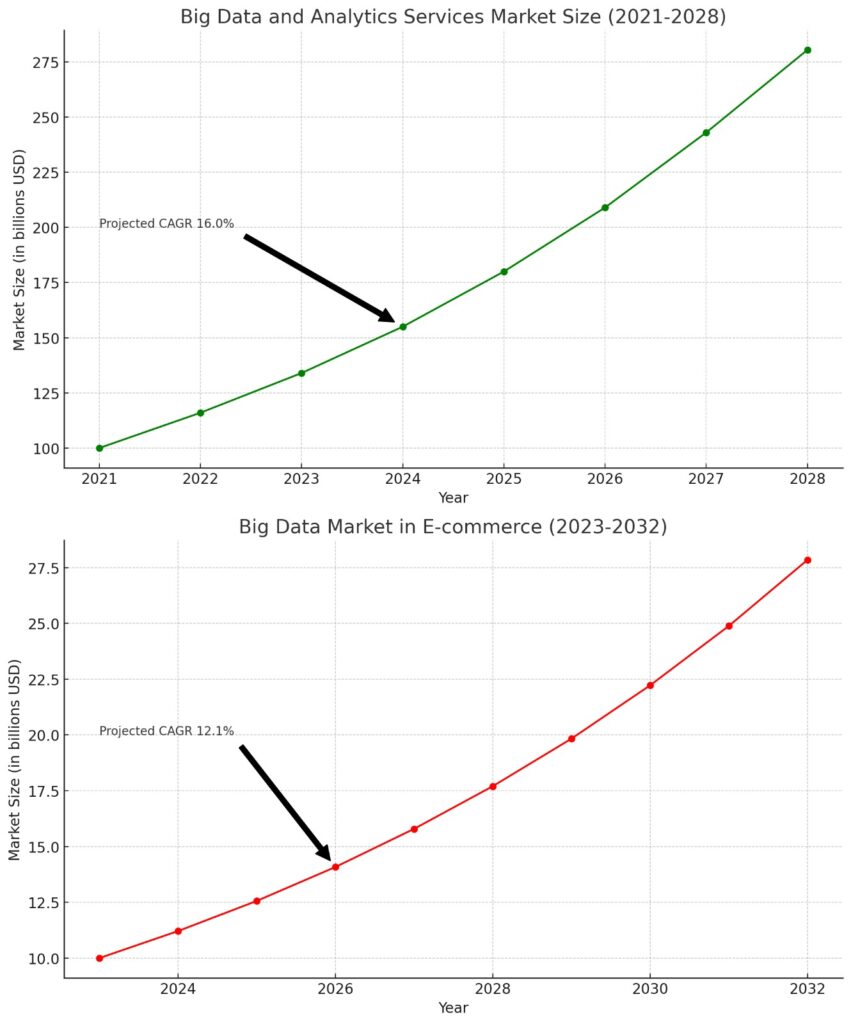
More breakthroughs in the field are expected. Leveraging big data analytics and technologies, this form of e-commerce personalizes the shopping experience, fosters deeper customer engagement, and ultimately drives sales growth.
- Big Data in Retail – Big data involves gathering vast amounts of customer data, including purchases, preferences, and browsing behavior. This data is analyzed to personalize shopping experiences and potentially influence future buying decisions.
- Big Data in Finance – The impact of big data in finance goes beyond just numbers. It’s about leveraging information to make smarter decisions, improve customer experiences, and navigate the ever-evolving financial landscape.
- Make data-driven decisions: Gain insights to improve customer experiences and navigate the changing financial landscape.
- Embrace the cloud: Leverage cloud solutions for scalability, cost reduction, and deeper analysis of vast datasets, leading to a richer understanding of markets and customer behavior.
- Enhanced Security: Cloud providers offer robust security solutions that protect financial institutions’ systems and data from cyberattacks.
For eg:- Jio Financial Services is developing a separate tech team to fine-tune AI to match investors with appropriate investment products based on their risk tolerance.
- Big Data in Insurance – Big data offers immense benefits for insurance companies, transforming how they assess risk, detect fraud, and engage customers.
For Eg:- Prudential leverages big data to assess risk profiles and offer tailored insurance plans to customers.
- Precise Risk Assessment: By analyzing vast datasets (demographics, claims history etc.), insurers can accurately predict the likelihood of claims, leading to fairer pricing and better risk management.
- Unmasking Fraud: Big data empowers insurers to identify fraudulent activity through analyzing patterns in policyholder and claims data. This helps reduce financial losses and protects legitimate customers.
- Targeted Customer Segmentation: By grouping customers based on behavior and preferences, insurers can tailor products, marketing, and customer service for improved satisfaction and loyalty.
A report by The Economic Times projects the Indian retail industry to reach over $2.2 trillion by 2030. This highlights the continued dominance of offline retail in India, despite the growth of e-commerce. While there’s substantial potential for direct-to-consumer (D2C) firms to expand into brick-and-mortar stores, physical retail is expected to remain the major player for the foreseeable future.
Size of the big data analytics market worldwide from 2021 to 2029 (in billions of U.S. dollars)
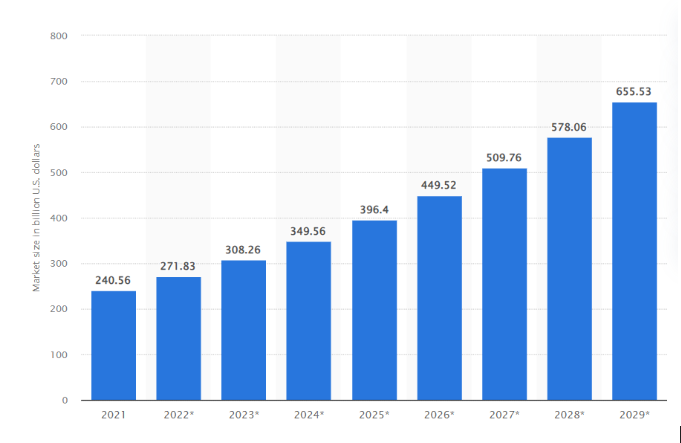
Table of Contents
Big data solutions
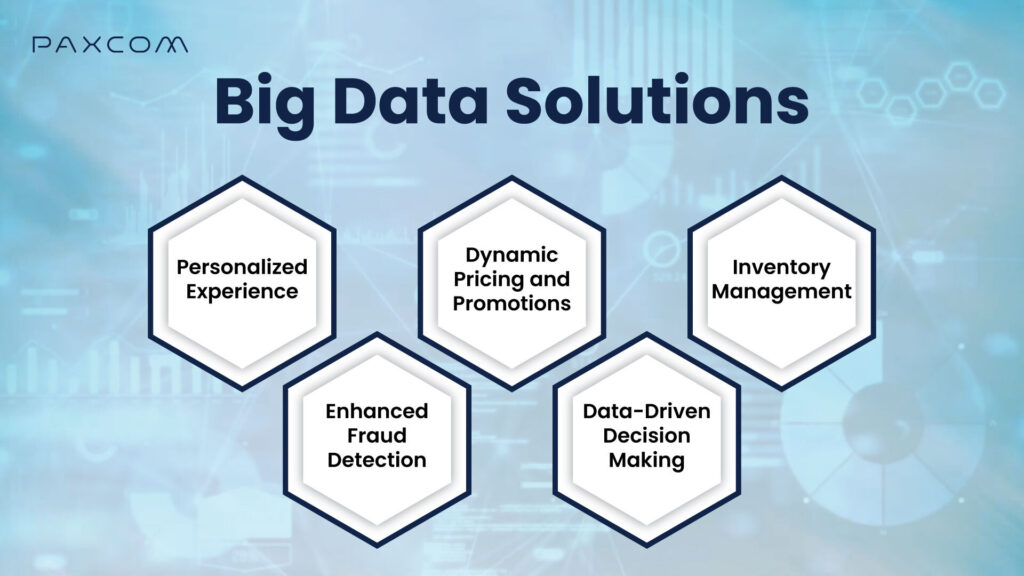
Data Storage:
- Scalability: Big data solutions handle massive datasets by distributing them across multiple servers (distributed storage) using technologies like Hadoop Distributed File System (HDFS).
- Variety: These solutions cater to structured (databases), unstructured (text, images), and semi-structured (JSON, XML) data through NoSQL databases and data lakes.
Data Processing:
- Velocity: Big data solutions handle high-velocity data streams (real-time) using technologies like Apache Spark for fast processing and analysis.
- Analytics: They provide tools and frameworks for data cleansing, transformation, and analysis to extract insights using techniques like machine learning and artificial intelligence.
Big data is a game-changer for e-commerce businesses, offering a treasure trove of information to boost sales, improve customer satisfaction, and stay ahead of the curve. Here’s how big data solutions are revolutionizing e-commerce:
- Big Data in Fashion
Personalized Experience: Big data paints a detailed picture of individual customers, their preferences, browsing habits, and purchase history. This empowers businesses to create personalized recommendations, targeted marketing campaigns, and loyalty programs, leading to higher conversion rates and customer engagement. Think Amazon’s product recommendations or Netflix’s movie suggestions—all powered by big data analysis.
- Myntra uses big data to analyze customer browsing behavior and purchase history. This allows them to recommend personalized outfits, predict upcoming fashion trends, and curate collections based on regional preferences.
- Shein: This fast-fashion brand uses big data to understand customer preferences across global markets. This allows them to tailor product offerings, optimize their supply chain to meet demand fluctuations, and personalize the shopping experience.
- Big Data in Food and Beverages
Starbucks, for example, uses location and 17 million-member mobile app data to personalize customers. Starbucks’ mobile app tracks what, where, and when customers buy coffee. The cloud-based AI engine, Digital Flywheel, processes data to provide accurate food and drink recommendations. This enables Starbucks customers to have a customized experience at new locations. The store’s point-of-sale system and the customer’s smartphone app can detect and notify the barista of their order, creating a seamless and personalized experience. Starbucks analyzes regional tastes to generate localized menu items. Starbucks employs advanced mapping and business intelligence technology (Esri Atlas) for location-based analytics. This tool may help Starbucks assess population density, income, traffic, competitors, and retail proximity.

Example: BigBasket analyzes past purchases to recommend complementary products. For example, if a customer buys breakfast cereal, the platform might suggest milk or fruits. This upselling and cross-selling strategy increases customer basket size and overall revenue
- Dynamic Pricing and Promotions: E-commerce businesses can leverage real-time analytics to adjust prices based on competitor pricing, market trends, and customer demand. This ensures they stay competitive while maximizing profits. Big data also helps craft targeted promotions and discounts to incentivize specific customer segments.
For example:-
- Amazon, a master of dynamic pricing, uses big data to adjust product prices in real-time based on factors like demand, competitor pricing, and customer location. They also personalize promotions with targeted discounts and coupons based on past purchases and browsing behavior.
- Flipkart leverages big data to analyze competitor pricing, product popularity, and seasonal trends. This allows them to optimize pricing strategies in real-time and ensure they have adequate stock based on predicted demand for electronics like smartphones and laptops.
Big Data in Pharmaceuticals & Healthcare:
- Solution: Targeted Product Recommendations & Patient Data Analysis
- Example: 1mg (an online pharmacy) uses big data to analyze customer demographics and purchase history. This allows them to recommend relevant over-the-counter medications and healthcare products. Additionally, anonymized patient data can be used for disease prediction and targeted health awareness campaigns.
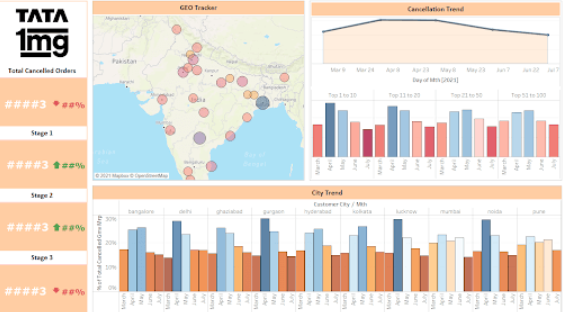
Big Data in Manufacturing – Predictive Maintenance and Supply Chain Optimization (GE):
Big Data helps in anticipating equipment failures and optimizing production processes. Big data analysis of sensor data from machines allows for predictive maintenance and efficient resource allocation.Benefits include, reduced downtime, cost savings, and improved overall production efficiency. For eg:-
GE utilizes big data solutions through their Industrial Internet platform to focus on predictive maintenance and supply chain optimization in manufacturing thus resulting in cost savings, improved efficiency, and a smoother running operation for manufacturers.
- Sensors on machines collect real-time data on performance.
- Big data analysis identifies patterns that predict potential failures.
- Proactive maintenance is scheduled to avoid breakdowns and downtime.
- Supply chain resources are allocated more efficiently based on real-time data.
Inventory Management: By analyzing sales data and customer behavior, businesses can predict demand fluctuations and optimize inventory levels. This reduces the risk of stockouts and overstocking, ensuring a smooth customer experience and efficient cash flow management.
Big data empowers brands to:
- Eliminate stockouts and overselling: By predicting demand and optimizing inventory levels, brands can ensure they always have the right products in stock, preventing lost sales and frustrated customers.
- Expedite order fulfillment: real-time data analysis allows for faster processing and efficient order routing, leading to quicker deliveries and happier customers.
- Maximize margins and operational efficiency: Smarter inventory management reduces storage costs, excess stock, and handling expenses, resulting in increased profitability.
- Additionally, big data improves customer satisfaction by:
- Simplifying product returns and shipping: Data insights can streamline these processes, minimizing customer hassle and boosting satisfaction.
- Guiding smarter purchases: Personalized recommendations based on customer behavior lead to more relevant product suggestions, improving the overall shopping experience.
Enhanced Fraud Detection: Big data analytics can identify suspicious patterns in customer behavior that might indicate fraudulent transactions. This helps businesses implement robust security measures to protect themselves from financial losses.
For eg:- Many Indian FinTech startups like Zoho are built around using big data for financial services like loan approvals and wealth management.
American Express: Analyzes data to detect fraudulent transactions and identify potential churn, allowing them to take preventive measures.
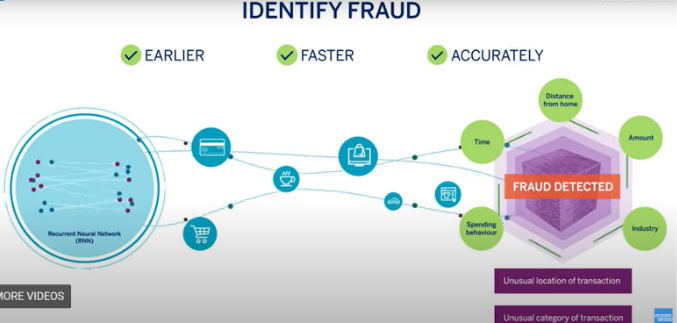
Data-Driven Decision Making: Big data provides valuable insights into every facet of the e-commerce business, from marketing effectiveness to operational efficiency. This empowers data-driven decision-making, allowing businesses to allocate resources strategically and optimize their overall performance.
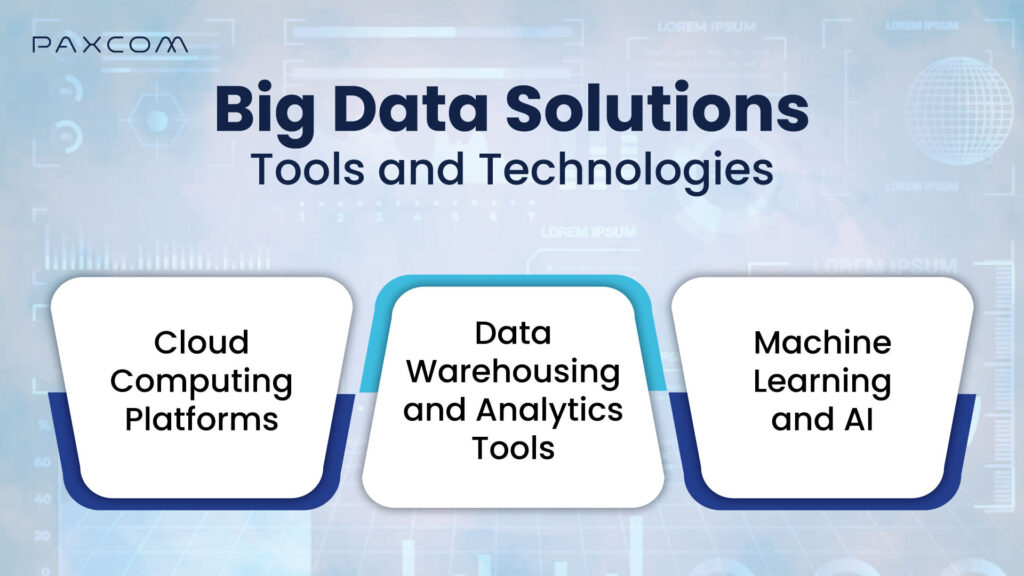
Big data solutions encompass a variety of tools and technologies, including:
- Cloud Computing
Scalable cloud computing platforms are essential for efficiently storing and processing large datasets. Cloud computing platforms have become the foundation for big data solutions. These platforms provide the scalable, on-demand infrastructure needed to store, process, and analyze massive datasets. Here are some of the leading cloud computing platforms that offer big data solutions:
For eg:- Amazon Web Services (AWS): AWS offers a wide range of big data services, including Amazon S3 for storage, Amazon Elastic Compute Cloud (EC2) for compute, and Amazon EMR for running Apache Hadoop and Spark clusters.
- Data Warehousing and Analytics Tools:
These tools aggregate data from various sources, enabling in-depth analysis and visualization of customer behavior and market trends.
- Machine learning and AI: Machine learning algorithms can analyze vast amounts of data to identify patterns, predict customer behavior, and automate tasks like personalized recommendations.
Extracting valuable insights from the vast amount of data (big data) is critical for businesses in today’s data-driven world. This empowers them to make informed decisions. Here’s a breakdown of the best solutions and practices for tackling this challenge:
Data Storage:
Distributed Storage: Traditional databases struggle with large volumes. Big data solutions like Hadoop Distributed File System (HDFS) distribute data across multiple servers, enabling scalability and efficient handling of massive datasets.
Data Lakes: Not all data is neatly structured. Data lakes act as central repositories for storing structured, unstructured (text, images, social media data), and semi-structured (JSON, XML) data in its raw form. This allows for flexibility in future analysis, without the limitations of traditional databases.
Data Processing:
Big Data Frameworks: Apache Spark and similar frameworks excel at processing large datasets quickly. Spark utilizes in-memory processing, significantly accelerating tasks compared to traditional methods.
Stream Processing: For real-time data analysis, solutions like Apache Kafka act as a messaging system that ingests and processes continuous data streams. This is crucial for applications like fraud detection or recommendation systems.
Data Pipelines: These automated workflows extract, transform, and load (ETL) data from various sources into a usable format for analysis. Data pipelines ensure data consistency and quality, resulting in reliable insights.
Data Management and Security:
Data Governance: With vast amounts of data, establishing clear ownership, access controls, and data quality standards is crucial. Data governance frameworks ensure responsible data collection, storage, and usage.
Data Security: Protecting sensitive data is paramount. To prevent unauthorized access and data breaches, big data solutions incorporate robust security measures such as encryption and access controls.
Data Analysis and Insights:
Data warehouses: These store historical data specifically designed for analysis. Data warehouses provide a centralized platform for querying and generating reports to identify trends and patterns.
Machine learning and AI: Advanced analytics unlock deeper insights from data. Massive datasets can train machine learning algorithms to uncover hidden patterns and generate predictions, enabling data-driven decision-making.
Best Practices:
- Start with a clear objective: define what insights you want to gain from your data before choosing solutions.
- Focus on data quality: “Garbage in, garbage out” also applies to data. For reliable results, ensure the data’s accuracy and consistency.
- Invest in skilled professionals: Data scientists and data engineers are crucial for managing and analyzing big data effectively.
- Embrace a data-driven culture. Encourage data-based decision-making across all levels of your organization.
The e-commerce world thrives on data, but managing its ever-growing volume (velocity), variety, and complexity can be a challenge. Here’s a breakdown of the best solutions and practices for handling big data in e-commerce:
Data Storage Solutions:
- Cloud-based data warehouses: move away from traditional on-premise solutions. Scalable cloud platforms like Amazon Redshift or Google BigQuery offer cost-effective storage and on-demand resources to handle massive datasets.
- Data Lakes: Embrace flexibility with data lakes. These central repositories store all data formats (structured, unstructured, and semi-structured) for future analysis, allowing you to explore new possibilities as your business needs evolve.
Data Processing Solutions:
- Distributed Processing Frameworks: Harness the power of parallel processing. Frameworks like Apache Hadoop and Apache Spark distribute data processing tasks across multiple servers, significantly increasing speed and efficiency for large datasets.
- Real-time Streaming Analytics Platforms: Respond instantly to customer behavior. Solutions like Apache Kafka or Apache Flink process high-velocity data streams in real-time, enabling you to personalize recommendations, detect fraudulent activities, and optimize marketing campaigns based on current trends.
Data management practices:
- Data Governance: Establish clear ownership and guidelines for data collection, storage, access, and usage. This ensures data quality, security, and compliance with regulations.
- Data Integration: Break down data silos. Integrate data from various sources, like customer relationship management (CRM) platforms, marketing automation tools, and social media, to gain a holistic view of customer behavior.
- Data Cleansing and Transformation: Ensure data accuracy and usability. Implement data cleansing techniques to remove inconsistencies and errors, and utilize data transformation tools to convert data into a format suitable for analysis.
Advanced analytics techniques:
- Machine Learning (ML): Unlock hidden patterns. Leverage ML algorithms to predict customer behavior, personalize product recommendations, optimize pricing strategies, and improve fraud detection.
- Artificial Intelligence (AI): Gain deeper customer insights. Utilize AI chatbots for personalized customer service, product recommendations based on past purchases and browsing history, and dynamic content creation based on real-time data.
Conclusion:
- Focus on Business Goals: Align your big data strategy with your overall business objectives. Identify key performance indicators (KPIs) and leverage data to achieve them.
- Invest in Data Talent: Having the right skills is crucial. Invest in data engineers, data analysts, and data scientists who can manage, analyze, and interpret your data effectively.
- Data security is paramount; protect sensitive customer information. Implement robust security measures to ensure data privacy and compliance with regulations.
By adopting these big data solutions and practices, e-commerce businesses can transform big data into actionable insights, driving better decision-making, optimizing operations, and ultimately achieving a competitive advantage. Big data analytics is playing a major role in the global economy. Organizations have already made significant investments in cloud computing, data infrastructure, and large processing power, which will facilitate the development of AI and GenAI technologies. AI will not only improve productivity but also shape the priorities of global businesses.
2024 presents excellent potential for the e-commerce sector, as advancements in big data solutions continue to reshape the economic environment. Businesses must leverage these powerful tools to remain competitive and provide exceptional customer shopping experiences.
For more information, please contact us at info@paxcom.net.














